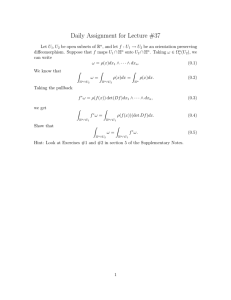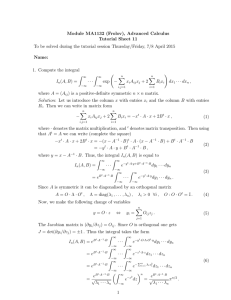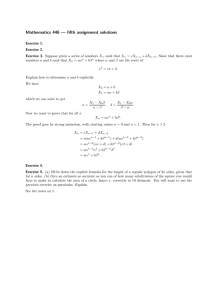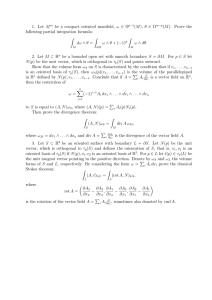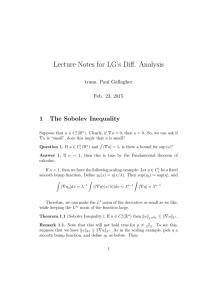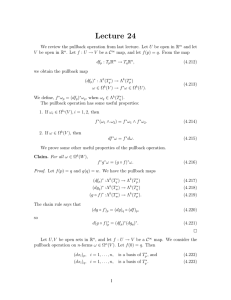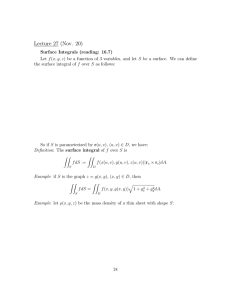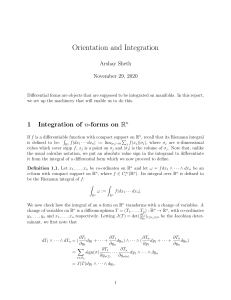Document 13570071
advertisement
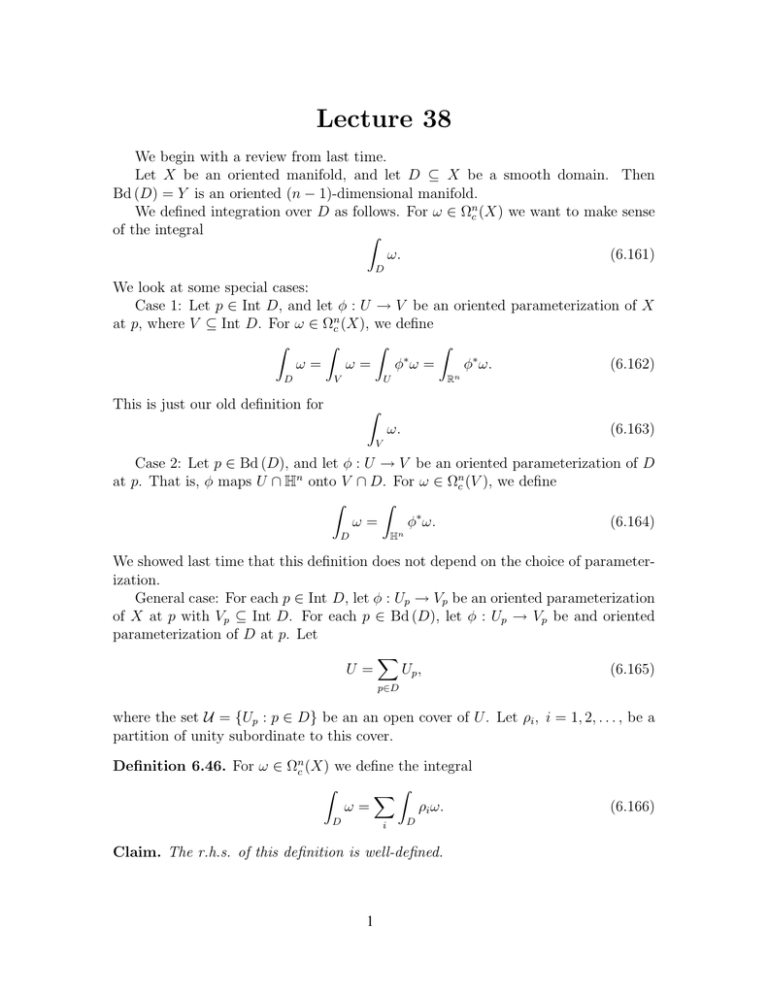
Lecture 38
We begin with a review from last time.
Let X be an oriented manifold, and let D ⊆ X be a smooth domain. Then
Bd (D) = Y is an oriented (n − 1)­dimensional manifold.
We defined integration over D as follows. For ω ∈ Ωnc (X) we want to make sense
of the integral
�
ω.
(6.161)
D
We look at some special cases:
Case 1: Let p ∈ Int D, and let φ : U → V be an oriented parameterization of X
at p, where V ⊆ Int D. For ω ∈ Ωnc (X), we define
�
�
�
�
∗
ω=
ω=
φω=
φ∗ ω.
(6.162)
D
V
Rn
U
This is just our old definition for
�
ω.
(6.163)
V
Case 2: Let p ∈ Bd (D), and let φ : U → V be an oriented parameterization of D
at p. That is, φ maps U ∩ Hn onto V ∩ D. For ω ∈ Ωnc (V ), we define
�
�
ω=
φ∗ ω.
(6.164)
Hn
D
We showed last time that this definition does not depend on the choice of parameter­
ization.
General case: For each p ∈ Int D, let φ : Up → Vp be an oriented parameterization
of X at p with Vp ⊆ Int D. For each p ∈ Bd (D), let φ : Up → Vp be and oriented
parameterization of D at p. Let
�
U=
Up ,
(6.165)
p∈D
where the set U = {Up : p ∈ D} be an an open cover of U . Let ρi , i = 1, 2, . . . , be a
partition of unity subordinate to this cover.
Definition 6.46. For ω ∈ Ωnc (X) we define the integral
�
��
ω=
ρi ω.
D
i
D
Claim. The r.h.s. of this definition is well­defined.
1
(6.166)
Proof. Since the ρi ’s are a partition of unity, there exists an N such that
supp ω ∩ supp ρi = φ,
(6.167)
for all i > N .
Hence, there are only a finite number of non­zero terms in the summand. More­
over, each summand is an integral of one of the two types above (cases 1 and 2), and
is therefore well­defined.
Claim. The l.h.s. of the definition does not depend on the choice of the partition of
unity ρi .
�
Proof. We proved an analogous assertion about the definition of X ω a few lectures
ago, and the proof of the present claim is exactly the same.
6.11
Stokes’ Theorem
Stokes’ Theorem. For all ω ∈ Ωn−1
(X),
c
�
�
dω =
D
ω.
(6.168)
Bd (D)
Proof.
Let ρi , i = 1, 2 . . . , be a partition of unity as defined above. Replacing ω with
�
ρi ω, it suffices to prove this for the two special cases below:
Case 1: Let p ∈ Int D, and let φ : U → V be an oriented parameterization of X
at p with V ⊆ Int D. If ω ∈ Ωn−1
(V ), then
c
�
�
�
∗
dω =
φ dω =
dφ∗ ω = 0.
(6.169)
Rn
D
Rn
Case 2: Let p ∈ Bd (D), and let φ : U → V be an oriented parameterization
of D at p. Let U b = U ∩ Bd (Hn ), and let V b = V ∩ Bd (D). Define ψ : φ|U b , so
ψ : U b → V b is an oriented parameterization of Bd (D) at p. If ω ∈ Ωn−1
(V ), then
c
�
�i ∧ · · · ∧ dxn .
φ∗ ω =
fi (x1 , . . . , xn )dx1 ∧ · · · ∧ dx
(6.170)
What is ψ ∗ ω? Let ι : Rn−1 → Rn be the inclusion map mapping Bd (Hn ) → Rn .
The inclusion map ι maps (x2 , . . . , xn ) → (0, x2 , . . . , xn ). Then φ ◦ ι = ψ, so
ψ ∗ ω = ι∗ φ∗ ω
� n
�
�
�i ∧ · · · ∧ dxn .
= ι∗
fi dx1 ∧ · · · ∧ dx
(6.171)
i=1
But,
ι∗ dx1 = dι∗ x1 = 0,
2
since ι∗ x1 = 0.
(6.172)
So,
ψ ∗ ω = ι∗ f1 dx2 ∧ · · · ∧ dxn
= f1 (0, x2 , . . . , xn )dx2 ∧ · · · ∧ dxn .
(6.173)
Thus,
�
�
ω=
�
∗
ψ ω=
f1 (0, x2 , . . . , xn )dx2 . . . dxn .
Rn−1
Bd (D)
(6.174)
Rn−1
On the other hand,
�
�
dω =
�
∗
φ dω =
Hn
D
dφ∗ ω.
(6.175)
Hn
One should check that
��
�
dφ∗ ω = d
fi dx1 ∧ · · · ∧ xx
�i ∧ · · · ∧ dxn
��
�
i−1 ∂fi
=
(−1)
dx1 ∧ · · · ∧ dxn .
∂xi
(6.176)
So, each summand
�
∂fi
dx1 . . . dxn
(6.177)
∂xi
can be integrated by parts, integrating first w.r.t. the ith variable. For i > 1, this is
the integral
� ∞
∂fi
dxi = fi (x1 , . . . , xn )|xxii =∞
=−∞
(6.178)
−∞ ∂xi
= 0.
For i = 1, this is the integral
� ∞
∂f1
(x1 , . . . , xn )dx1 = f1 (0, x2 , . . . , xn ).
−∞ ∂x1
Thus, the total integral of φ∗ dω over Hn is
�
f1 (0, x2 , . . . , xn )dx2 . . . dxn .
We conclude that
�
(6.179)
(6.180)
�
dω =
D
ω.
(6.181)
Bd (D)
We look at some applications of Stokes’ Theorem.
Let D be a smooth domain. Assume that D is compact and oriented, and let
Y = Bd (D). Let Z be an oriented n­manifold, and let f : Y → Z be a C ∞ map.
Theorem 6.47. If f extends to a C ∞ map F : D → Z, then
deg(f ) = 0.
(6.182)
Corollary 9. The Brouwer fixed point theorem follows from the above theorem.
3
